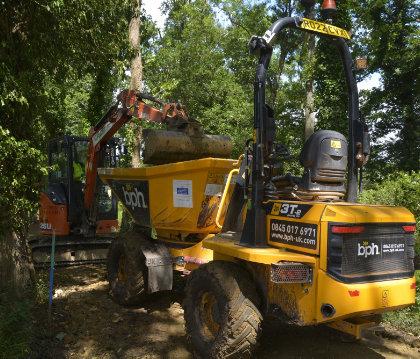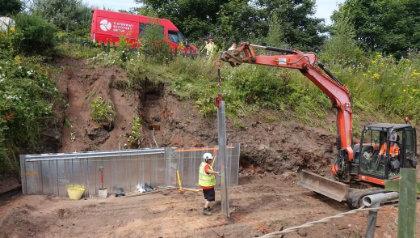










One of our more unusual summer Canal Camps spent a week on the Cromford Canal digging something that by the end of the Camp looked very much like a canal. Except that it isn’t a canal at all. So what is it? It’s a compensating pond being created on the floodplain of the River Erewash to replace the capacity for coping with floodwater which will be lost as a result of the construction of the actual canal at the later stages of the works. It’s part of the Friends of the Cromford Canal’s Beggarlee scheme to recreate the first section of canal northwardsfrom LangleyMillonanewalignmenttaking advantageofanoldfreightrailway bridgetogettherestoredcanalunder theA610mainroad.Seethenextissue forthefullcampreport;inthemeantime hereareaselectionofpictures
Alan Lines
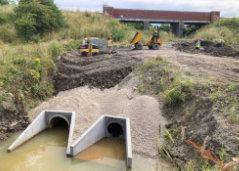

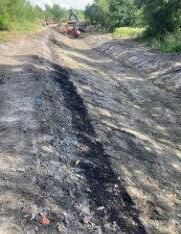
For latest news on our activities visit our website wrg.org.uk
See Facebook group: WRG
Welcome to our new readers from the editor 4-5
Chairman good news and not-so-good news from the world of canal restoration 6-7
Camp reports from the Lichfield Canal and two weeks on the Wey & Arun Canal 8-17
Diary Forthcoming Canal Camps and working weekends 18-19
Progress our regular roundup of news from around the system 20-31
Wooden boats Wooden Canal Boat Society take a trip on some restored canals 32-37
Infill Comments on Navvies gone by - and how NOT to do H&S paperwork… 38-39
PLEASE NOTE: subscriptions renewal cheques should be made out to The Inland Waterways Association.
Note new address (right)
Follow us on @wrg_navvies
Editor: Martin Ludgate, 35 Silvester Road, East Dulwich London SE22 9PB. 020-8693 3266 martin.ludgate@wrg.org.uk
Contributions welcome, by email or post, to the address above. If sending a lot of large picture files, please contact the editor first. Pressdateforissue327:15September.
Subscriptions: Ayear'ssubscription(6issues) isaminimum of £5.00 (please add a donation if you can) to WRG, Unit 16B, First Floor, Chiltern Court, Asheridge Road, Chesham HP5 2PX. Cheques must be made out to The Inland Waterways Association (although the proceeds will be put to WRG / Navvies use).
Distribution: John Hawkins, 4 Links Way, Croxley Green WD3 3RQ 01923 448559 john.hawkins@wrg.org.uk
Navvies is published by Waterway Recovery Group and is available to all interested in promoting or supporting the restoration and conservation of inland waterways by voluntary effort in Great Britain. Articles may be reproduced in allied magazines provided that the source is acknowledged.
WRG may not agree with opinions expressed in this magazine, but encourages publication as a matter of interest. Nothing printed may be construed as policy or an official announcement unless so stated - otherwise WRG and IWA accept no liability for any matter in this magazine.
Waterway Recovery Group is part of The Inland Waterways Association, (registered office: Unit 16B, First Floor, Chiltern Court, Asheridge Road, Chesham HP5 2PX), a nonprofit distributing company limited by guarantee, registered in England no 612245, and registered as a charity no 212342. VAT registration no 342 0715 89.
Directors of WRG: Rick Barnes, George Eycott, Helen Gardner, John Hawkins, Dave Hearnden, Nigel Lee, Mike Palmer, George Rogers, Jonathan Smith, Harry Watts.
ISSN: 0953-6655
© 2024 WRG
Cover picture: A big earth-shifting exercise on the Cromford Canal Camp - see opposite page, full report in next issue (picture: John Hawkins). Back cover upper: More machines in action on the Wey & Arun Canal camps, laying a towpath at Bonfire Hanger - see pages 8-14 (picture: Ian Stewart). Back cover lower: And even more machinery: piling the steep offside bank on the first of two Lichfield Canal Camps on a site near Fosseway Heath - see pages 15-17. (picture: Lichfield & Hartherton Canals Restoration Trust)
Editor Martin explains what this magazine’s about, for the benefit of any newcomers from the summer Canal Camps… and anyone else…
Navvies magazine? What’s that all about?
You may be wondering exactly that, if you’re a first-time volunteer on one of our summer Canal Camps and this issue has arrived unexpectedly through your letterbox. As a new recruit to Waterway Recovery Group, you’ll be receiving a free year’s subscription to our own magazine.
You might also be wondering (and this probably applies to lots of our existing readers too) why it’s called Navvies. Well, that’s because it takes its name from the original navvies (short for ‘navigators’) of 200 or more years ago, the labourers who built the canals, travelling all around the country to where their work was needed next – rather like we do today (but probably with rather more beer and fighting).
As you’ll see if you turn a few pages, we’ve already got reports from the first four Canal Camps of this summer’s programme – so you can refresh your memories of your own camp or find out what you missed on the others, whether you were on the Wey & Arun Canal, the Cromford Canal, or the Lichfield Canal. And if you were on one of the later canal camps, on the Louth, the Lapal, or the Cotswold Canals, you won’t just get to read about it next time, you could get to write about it…
Yes, as I said, it’s “our own” magazine, we get to write it too. So please let’s have some reports from the rest of the summer’s camps. So far we’ve mainly had straightforward ‘diary’ type reports – feel free to follow this style, or alternatively to let your creative talents run wild: in the past we’ve had camp reports written in rhyme, in biblical style, in the form of a school chemistry lab report (yes, really!) and more.
Our diary sits in the middle of the magazine as usual – and although it’s a little bit sparse now that summer’s coming to an end and there aren’t so many week-long camp coming up, the regional and other mobile working party groups are out and about on working weekends and would welcome new volunteers, even if you don’t come from their ‘home’ part of the country. For example London WRG has regulars from Devon and Merseyside! But I’m afraid we still haven’t found a worksite for our annual Reunion (or ‘Bonfire Bash’) big working party in early November – surely there’s a project somewhere out there which would welcome (and could accommodate) 100 volunteers for a weekend’s work? If you are involved in a canal society which could host this, please get in touch now!
Flicking on a bit further through the magazine, you’ll see we’ve got an assortment of progress reports with the latest good news from the wider world of waterway restoration, from the Stover Canal in the southwest (ish) to the Chesterfield in the northeast (ish). But on that subject, at this point I’d like to mention that it’s not all good news right now. Regular readers will be aware that it’s about this point in my editorial piece that I sometimes launch into a diatribe going into the political aspects of waterway restoration. Whilst you are obviously free to jump forward to the final paragraphs if this isn’t your thing, there is a way that you can help with this particular issue...
Mick Lilliman

The Wilts & Berks Canal has been under restoration for 40-odd Bricklaying by boat at Louth - report next time (please!)
years. It was never going to be a quick restoration because it’s a tricky one – several towns including Swindon and Abingdon having expanded to obliterate parts of its route since it closed in 1914 – but away from these towns there are many miles of surviving waterway and some significant progress has been made. Now, however, it’s under threat from something which could (and until recently looked like it would) actually provide a major benefit to the restoration. That ‘Something’ is the new Thames Water reservoir known as the South East Strategic Reservoir Option (SESRO) which is planned for the area south west of Abingdon.
Sign the petition!

Scan the code to support the Wilts & Berks Canal
This is planned to occupy part of the route of the old canal, so it could be seen as a problem for restoration. However, new reservoirs are required to have emergency draw-down channels in case they ever need to be emptied in a hurry. And in this case, one option for the draw-down channel is to build it as an open channel from the reservoir to the Thames at Abingdon, large enough that it would form the new easternmost few miles of the restored canal, entering the Thames via the short channel that we built as a volunteer project back in 2006.
This would provide several miles of navigable canal, getting around the problem section that’s disappeared under Abingdon, giving the canal one of its links to the rest of the waterways network, and making the sort of progress towards eventual completion that might otherwise take many years – as well as providing all the other benefits canals provide for nature, walkers and other local users.
A win all round. Except that Thames Water has now decided that its preferred option is to instead use a big underground pipe, with no canal restoration benefits. And the reservoir would still block the canal’s original route, making restoration harder.
So what can we do? Well, if you get this in time, you might just be able to reply to the consultation on the reservoir by the 28 August deadline – go to https://thames-wrmp.co.uk/ sesro, scroll down to the ‘Public consultation’ bit, follow the link to ‘complete questionnaire’ , and answer each question (you can do a ‘no comment’ answer if you like). When you get to the one that begins “We have considered several options for the emergency discharge and Option C is SESRO’s preferred option.” reply to this in your own words, putting across the points above (assuming you agree with them!) or any others you think are important.
And one other thing you can do is sign the online petition – the QR code on this page will take you there (and note that you don’t have to make a donation).
But coming back to this issue of Navvies, there’s something a bit unusual this time, and that’s a blow-by-blow account of taking a pair of historic wooden working narrow boats down the Ashton Canal and the ‘Rochdale Nine’ locks through central Manchester. No, it’s not a canal restoration article. It’s not even a boat restoration article. But I’ve included it anyway because the group concerned, the Wooden Canal Boat Society, are a splendid bunch who spend their time maintaining these historic and in some cases unique boats (and wooden ones take far more work than modern steel hulls), and who could do with more volunteers to help with both the restoration work and making sure that the boats see some actual use. And also because it ties together a couple of other things. In the last issue we covered the 50th anniversary of the reopening of the canals they travelled - the Ashton Canal and the Rochdale Nine (OK the Nine actually opened two years later after many delays). A few years before that, these routes were derelict, impassible and under threat of official abandonment, and people were calling for them to be filled in as a health and safety hazard. To many they didn’t look to have much future – like the Wilts & Berks might have seemed at times in more recent decades. The restoration movement saved the Ashton and the Rochdale Nine back then; let’s do our best for the Wilts & Berks now.
And finally, this issue sees the return of the ‘Infill’ inside back page oddities feature. This time we’ve got a splendid demonstration of how not to fill in H&S paperwork, and some interesting comments from WRGies on issues of Navvies from days gone by (and there will be more next time). And I hope to bring back our very own agony aunt Deirdre. You have been warned…
See you on a working party somewhere!
Martin Ludgate, Navvies Editor
“History (and this magazine!) shows us that the best way to get a message across is for everyone to state it and to keep repeating it.”
An inevitable feature of a magazine such as Navvies is that the same (or at least similar) messages can be read on different pages. There are several causes of this:
• Many sites/projects/events are very similar – leading to repeated messages such as “always make sure you have enough fuel for the excavator/mixer/pump before you start work”.
• Many WRG volunteers are very similar – leading to repeated messages such as “always put the van keys in the agreed place, which is not your pocket)”.
• WRG is an organisation that thrives on common ways of working – leading to repeated messages such as “a tidy site is a safe site”.
But there is one important reason why you may read the same words on different pages of the same issue: because it’s an important message and we need to ensure it lands well with everyone.
Which is my reasoning for starting my Chairman’s comment with the same message that Martin started his Editor’s comment on page 4-5 with:
The message might also continue with “We deliberately give new volunteer bookings a year’s free subscription to Navvies because we believe it’s a good portal into the world of waterway restoration. You may find all of these pages a baffling (maybe even worrying) onslaught of information, opinions, jokes, memories, etc. But don’t worry – we are a fairly welcoming bunch and soon it will all start to make sense”. However, all of that isn’t quite as eloquent as Julie Howard on page 17…
“If you are flicking through this issue and wondering if you should join the volunteers, stop dithering and get your name down. You will have a wonderful time”.
Readers whose memory can stretch back to November last year may remember that I again quoted our Editor when he stated that, in that edition of Navvies:
“Not only is there a lot of news, a lot of that news is good news.”
This edition of Navvies brings lots of news too, and a lot of it is good news. Yes, there is the “big bang” stuff such as the major progress on the Cotswolds / Lichfield / Chesterfield
Does your group have lifting gear that needs inspecting?
Terry Cavender of Buckingham Canal Society is now a member of the IIRSM (The International Institute of Risk and Safety Management - www.iirsm.org) and certified to undertake LOLER (Lifting Operations and Lifting Equipment Regulations 1998) inspections.
Feel free to contact him for more details. Discounted rates for waterway restoration groups.
canals, together with the more “steady state” stuff such as Wey & Arun / Lichfield (again) / Stover / Montgomery / Shrewsbury & Newport.
But we cannot (and must not) ignore the fact that there is also bad news. Please do read Martin’s report on the potential impact of the reservoir at Abingdon on the Wilts & Berks Canal. It’s not my place to tell you what your response to the consultation should be, but I will implore you to respond. You may feel that the Wilts & Berks is not “your” restoration. Well, it’s true that we do all have our favourites but that’s not really the point is it? History (and this magazine!) shows us that the best way to get a message across is for everyone to state it and to keep repeating it.
If, by any chance, you are struggling to put over why waterway restorations should not be adversely affected by developments, then feel free to reference our parent body the Inland Waterways Association’s report Waterways for Today (available on the IWA website). It’s an inspiring, authoritative and comprehensive vision of why waterways should matter to everyone – the many benefits that waterways bring to the UK.
This is not just a local matter - if the Wilts & Berks suffers a poor result then that ‘result’ becomes a precedent that could be applied to other restorations.
Actually, while I’m on the subject of local matters that have national importance, you may have noticed that there was a General Election recently and so, perhaps you have a new MP. They too need to be educated as to the benefits of waterways, so perhaps you would consider introducing them to the benefits outlined in Waterways for Today?
Finally there are six pages that should be considered good news: a fascinating account of taking boats around those canals whose restoration was filling the pages of Navvies fifty years ago. Now I’m not suggesting all was plain sailing on this cruise, however the mere fact that, fifty years later, these canals are still able to be used should give us reassurance…
The pages of Navvies may well continue to (occasionally) contain news of threats / missed opportunities / unwise decisions. However, our messages are good and, if we all continue to push them, we shall continue to add more miles that will be used, enjoyed and bring benefits to all.
Mike Palmer
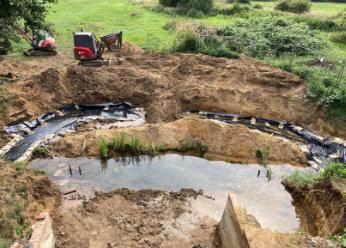
Regional group NWPG report from the first of two weeks of intensive machinery operations laying a new towpath north of Loxwood
NWPG Canal Camp, 29 June-6 July
Billed as the start of the Rooks Hill project (which involves construction of a new lock and brick arched bridge), in true camp tradition this was not to be… Planning permission had not been granted – and at the time of writing is still not in place. However, we had an instant backup project in that we needed to rebuild 1 km of public footpath and bridleway at Bonfire Hanger, Alfold. This work was going to be the subject of two weeks of WRG camps at the end of August. However it was decided that both of the independent mobile volunteer groups NWPG and KESCRG should start work early on what will be an entirely new towpath for all users.
The Bonfire Hanger section comprises 1 km of canal, centrally located between the River Wey and the River Arun and in the middle of the climb from the Arun valley to the canal’s summit at Dunsfold Aerodrome (see map, page 12). It contains the sites of four former locks which are now only distinguishable by barely noticeable rises in ground level. Those volunteers who can remember back to 2002 will recall the Dig Deep project there (Dig Deep was an initiative to coordinate work on selected suitable projects in the south of the country by visiting volunteer groups including NWPG, KESCRG and WRG regional groups) to construct brick dams at the head of the locks 9 -11 as well as two footbridges. The canal at this stage was leased to the Wey & Arun Canal Trust (WACT) and although the brick dams held water at times, winter flooding led

to water passing though a leaky bank into the adjacent fields and complaints from the landowner. The dams were subsequently breached but left so that they could be reinstated reasonably easily.
The footbridge above the canal near Lock 10 remains well used by ramblers being on a circular walking route.
The lease at Bonfire Hanger expired a couple of years ago and the canal started to return to its original overgrown state. However, in 2023 a land exchange deal between two land owners and the Canal Trust (who owned some land at Gennets Bridge Lock) brought the whole Bonfire Hanger length into Trust ownership. This extended northwards from the length to the south that the Trust had bought in 2022. The way was now open for restoration with the first task being to improve the diabolical state of the bridleway/footpath. That is where the story reaches the present day and the WRG Summer Camps.
Incidentally the restoration of the locks is for the long term, although it is possible that the dams might be reinstated to allow the pounds to flood in winter.
Preparatory work for the camps was extensive. WACT’s mid-week group spent many weeks felling trees that had grown up in the middle of the path as well as in the canal. This was necessary to achieve the target 2.5m width with 3m where possible as this would allow small vehicles to access the canal. Complicating the issue was the fact the the northern 60 metres was still in private ownership and not usable for plant or access. This meant that everything has had to come in from the south which had consequences for the progress of the camps.
With the trees largely gone, and the camp due to start on the last Sunday of June, the first task was
to excavate a level base over as much of the length as we could over the first weekend of the camp. Early starts and late finishes by digger drivers Pete Bunker and Adam ‘Digger’ Morris (out from retirement for this special project!) saw the levelling off of the worst 700m of the path ready for stone laying to start. The stone being used is no ordinary Type 1 limestone but a sandy coloured local stone from the quarry at Fittleworth to the west of Pulborough. This is the stone preferred by horse riders as it doesn’t have sharps that cut into hooves. Of course being in Surrey / Sussex it is also expensive! The Trust was therefore pleased to receive grants from local authority Community Infrastructure Levies of £45,000. This is expected to cover about 66% of the total cost. The snag is that you don’t get the
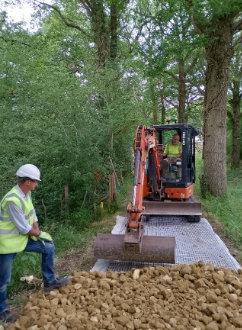
money until you’ve finished the job – again more on this later.
Work on placing the base stone started in earnest on the Monday – but not before the job had been extended to Rosemary Lane following the intervention of the Surrey Footpaths Officer who rightly intimated that to leave the last 60 metres untouched would be nonsense. He advised that he could instruct the works whether or not the land owner consented. He proceeded to do just that! However, a quick knock on the owner’s door followed and all was agreed. This was a plant intensive camp. WACT’s Dave Evans, on his last job with the Trust before moving on to pastures new, had ordered 6 x 3 tonne swivel dumpers, a 3 tonne excavator to spread the material, a siton roller and an 8 tonne excavator to load and manage the stockpile of stone at the site compound. Add to this the Trust’s own 6 tonne excavator and it was clear that we
were going to need a lot of people with dumper and digger tickets.The compound was set up in advance adjacent to Gennets Bridge Lock and was to be the base for all of the planned camps.
The camp volunteers split into teams who broadly did the same job for the whole week and as a result became quite specialist in their areas of work. We did some early training on dumpers for Zoe, Dave Rumble, Harry and Aussie Mike which bought our total to nine drivers not including those on the excavators and roller. Working on a long length of single-width track with only a few passing places it was necessary to devise a system of operation that avoided dumpers meeting in the wrong place and having to reverse. Step in Pete Turville, NWPG’s railway expert who produced a token system preventing any driver from entering a section without the correct coloured token. It seemed to work.

As a diversion and while we were getting ourselves sorted out, Phil and Harry were sent off to remove an earth causeway across the canal to the south of the camp work site. Material from this was deposited in the adjacent field (owned by the Trust) and levelled. Meanwhile on the towpath-to-be, Duncan occupied the small digger: spreading the base stone that was far too large to move with rakes. Starting at the furthest exteremity of 1.2km from the compound, over the days of the camp Rob, Graham and Mike on the roller progressively edged their way south down the canal. On the best day over 100m of base stone was put down and levelled. Each day the distance to the stone pile was reduced with a consequent marginal increase in work rate.
Back at base, Steve Saunders had the onerous task of counting out the laden dumpers and keeping people, mainly cyclists, from ignoring the ‘footpath closed’ sign on the entrance gate that we had put up to keep non workers away from the action further
on. The number counting allowed us to produce some statistics for the week’s work:
• 630m of base stone laid at 200mm depth and 2.5m wide
• 503 tons of stone moved
• 600 litres of fuel consumed
• 266 x 3t dumper loads @ 1.8t per load
• c. 600km driven
We started the week with a pretty good stockpile of stone brought in the week before. By mid camp we were down to “not quite in time deliveries” which was beginning to slow us down. It didn’t matter as by then we had reached our physical limts and were ready to go home for a rest.
Away from the work our accommodation was at Kirdford Village Hall hired to us yet again by the kind villagers. We have been holding camps based at this hall since the mid 1980’s. Is this a record? This year we happened to pick the week of the General Election and of course the hall is used as the village polling station. Apparently the government can require any venue of its choosing to be made available for elections – previous bookings get evicted. Fortunately the hall has a back room which can be accessed independently and so the polling staff were put there and we kept the main hall and kitchen. We did have a number of electors who insisted on visiting us in closer detail marvelling at the rows of camp beds laid across the floor. Our camps wouldn’t be the same without our catering team of Sue, partner Dave and dumper counter Steve who covered the cooks’ night off. Thanks as always to them. This year there was enough water to have a boat trip in pleasant mid summer evening sunshine – reminding us why we do all this restoration stuff. We decanted to Wonersh one evening to play skittles and of course renewed friendships and made new ones over the odd glass of ale.
NWPG have done a few camps over the years and this was a good one that went to plan with good weather and only one
minor roller derailment. It was a tricky site to work on and keep safe and we were aided by the dry conditions. Thanks to Dave Evans for putting everything in place and to all the volunteers who made it all work.
Epilogue: As mentioned we were meant to have two camps at the end of August doing this work in addition to the Rooks Hill project. Unfortunately leadership teams could not be found to run these. Dave Evans always said that the job would take four weeks and he was spot-on. So with NWPG’s and KESCRG’s support WACT have arranged a further work session/camp from 15 – 22 August with a full footpath closure to hopefully progress the work to a point where local teams can finish it off. Only then will the Trust be able to claim back the £45K grant promised by the local authorities. Report next time.
Bill Nicholson

Base stone ready for KESCRG the following week
Regional group Kescrg take over the leadership for the second of two weeks of Canal Camps laying a new towpath north of Loxwood
Wey & Arun Canal, Bonfire Hanger
KESCRG Canal Camp 6-13 July
This camp was originally meant to be working on a new bridge near the Birtley section of the Wey and Arun canal but due to a delay in planning permission the camp was moved on to laying a new, horsefriendly towpath on the recently purchased Bonfire Hangar section (just above the navigable Loxwood locks).
Saturday: Stephen Davis and I met up with some of the Wey & Arun Canal Trust (WACT) on site who were continuing the good work done by the camp led by Newbury Working Party Group (NWPG) volunteers the previous week. The towpath was to be constructed in two layers – a base layer using 200mm stone which would be rolled down and then a topping layer of 40mm stone which also
would be rolled down. This rolling could only occur in the dry – not a problem for the NWPG week, but this proved more of a problem for our week!
Back to the hall which was our accommodation for the week, and volunteers started to arrive; the usual tool counting and hall preparation happened before the safety video and site specific presentation from Zoe (the new WACT apprentice) and Dave (the outgoing WACT operations manager), then dinner and a walk to the Half Moon pub for a drink and ‘get to know you’ session.
Sunday: Day one on site and a chance to get some training done – Alan trained Paul on dumpers and Adrian started training Ashvika (our lone Duke of Edinburgh’s Award candidate, good to see some back!) on excavators. Everyone else concentrated on moving dumper-loads of large stone to
Length: 23 miles Locks: originally 26 Date closed: 1871
The Canal Camp project: Laying a towpath alongside a length of canal at Bonfire Hanger
Why? Having spent a lot of the last 20 years concentrating on the Loxwood Link section (which is now around three miles long with seven completed locks) the Wey &Arun Canal Trust has recently bought the next length of canal extending further north from there. Reinstating the towpath extends a popular local walk, and represents a step towards restoring this length of canal.
The wider picture: In addition to working on the Loxwood Link section, WACT has in recent years adopted a ‘Three Sites’strategy aimed at making progress on other sections - the Summit near Dunsfold and near the north end of the canal. The length at Birtley and its extension south to the Fanesbridge and Rooks Hill area represents another new target for progress. In the coming years it is hoped to link these sections together to create longer navigable lengths, with the eventual aim of reopening the entire through route between the Thames and the South Coast.
Birtley lift bridges section
Rooks Hill site
River
Canal Camp site: Bonfire Hanger Restored Loxwood Link section Restored Summit length

continue the path foundation, while learning the intricacies of a ‘token’ system (rather like the system traditionally used on single-track railways) that effectively prevented dumpers meeting each other on the narrow route.
Some 32 dumper loads later (expertly levelled by William and rolled flat by Colin) it was time for home where we were reinforced by the arrival of Ian Williamson and Sophie.
Monday: Changeover day, the last 7 loads of large stone were laid and then we reconfigured to laying top stone – this extended the dumper run to about 1km, leading to slightly slower progress. The smaller stone also meant we could switch from using an excavator to hand raking the stone flat to give the required camber; 14 loads of small stone later and the first part of the path was looking really nice.
Tuesday: The day started damp and then got worse, so with the worksite already too wet to roll the towpath, we concentrated on

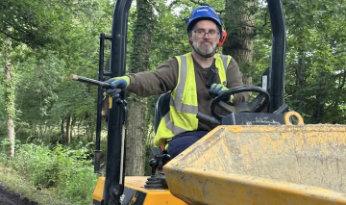
Exchanging tokens for the single-track towpath
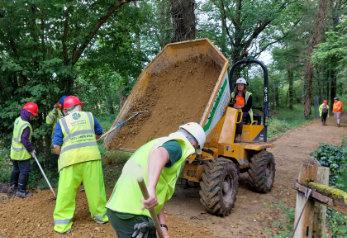
getting stone moved. By lunchtime (with 14 loads moved) we decided that it was just too wet to do any more and knocked off early. Tim arriving just as we were packing up was completely coincidental. Handily it was boat trip night on the Loxwood section with a scrumptious picnic dinner courtesy of Eli and Sophie.
Wednesday: Sunny! With drier weather and everyone now having a good idea of the work, we cracked on. The path was still too damp for rolling but 29 dumper loads were loaded, shifted, raked and levelled over the course of the day (about 150m of path). With the football being on in the evening, a few people headed off to the pub to watch the match while others took a trip to Birtley to inspect the lift bridges that had been built recently.
Thursday: More stone moving and raking –with only two days left before the towpath had to reopen to the public it was decided to concentrate on leaving the path in a good state. An expert raking team of Ashvika, Susan, Jon, Stephen and Ian Stewart concentrated on spreading the dumper loads of material while Colin and Ian Williamson
were doing tandem rollering as the path had finally dried out enough for this! Evening entertainment was skittles in Wonersh village hall where in a hard fought match, team RFB just beat team EHP and we found the oven has still not been fixed.
Friday: Last day and 27 loads of stone were moved (loaded by various excavator drivers as Adrian passed on his knowledge to Colin and William); much rolling and raking was done until we were finished! A last walk of the full length of the site to pull in all the signs and fencing meant we were slightly later getting back to the hall where awards and an excellent dinner from Eli awaited.
Thanks to everyone who came on the camp, we had some long days but got a lot done – the path looks really, really good and it should give some good PR for the local Trust. Particular thanks to Eli for cooking (not sure we had a single meal with the same number of people at it at any point in the week!), Sophie for all the baking, Stephen my assistant for raking beyond the call of duty and Adrian and Ian Williamson for being calm, knowledgeable and taking tasks off Stephen’s and my hands. Ed Walker
“Are you mad?” - Julie attempts to answer her colleagues’ question about her choice of a week’s piling and brickwork as a summer holiday
Lichfield Canal Camp 27 July - 2 August
Several days before the start of the Canal Camp my work colleagues asked me about my holiday plans. I told them I was heading to Lichfield to help rebuild part of an old canal and would be staying in a scout hut with a bunch of people I had never met. “Are you mad?” was their response… well, let’s see…
I arrived early on the Friday as we had to head off on Saturday morning to collect the vans. I spent a delightful evening eating pizza and hearing tales of previous camps. On Saturday the remainder of the group arrived. Four of us were new but
quickly felt at home with tea and a piece of Tina’s delicious cake. Marie, Daniel and Cameron were here to complete their gold Duke of Edinburgh’s Award, Steve and Jack were to be our cooks, and Will was deputy leader to Colin. Andy, Jordan, Pete ,Louise and Andrew all had worked with the group before, each bringing a mix of skills and humour. Our visit to the site triggered a lot of head scratching as they realised the complexities of the challenge ahead. The bank had a steep gradient. The pilings were not going to slide into place as shown on the video. They certainly had lots to think about. Returning from our site visit we found the table had been set with a doodle sheet for the week and a personal placement for
Length: 7 miles Locks: 30
Date closed: 1954
The Canal Camp project: Working on brickwork and steel piling channel walls near Fosseway Heath
Why? The brickwork wall is a historic towpath wall which has decayed and needs repairing, while the steel piling on the offside is needed to support a steep earth bank above the canal
The wider picture: The work on this section extends a section already restored including our worksite of a few years ago at Fosseway Heath and the restored Lock 18. These lengths link to the new sections of channel being built alongside the Lichfield Bypass, which in turn will connect to the restored Borrowcop section via a length which has just been given the go-ahead (see also our Progress pages).And from there it’s not too far to the recently completed Darnford Moors section, and to the Coventry Canal at Huddlesford Junction. So in the medium term there are prospects for opening up a significant length of canal connecting the Coventry Canal to Lichfield and beyond, as a major step towards the ultimate goal of reopening the through route to the navigable Wyrley & Essington Canal at Ogley Junction
The Lichfield Canal is the name given by canal restorers to the disused 7 miles and 30 locks from Ogley to Huddlesford which formed the eastern end of theWyrley & Essington Canal, part of the Birmingham Canal Navigations.
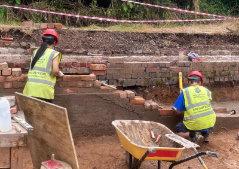
each of us, yet another thoughtful and much appreciated gesture. Our delicious pie & mash supper was followed by a walk up the ‘spoil’ heap to see the huge golden sundial.
Sunday: our first working day on site, all safely kitted up and divided into task groups. Will, Colin and Pete moved the piling sheets and skilfully transformed the bank ready for the piles to go in. The wall was dismantled and the bricks moved to the brick-cleaning station… “tap, tap, tap” began. In the afternoon it became apparent that the digger parts were not available to begin inserting the sheet piles, very frustrating. Time to call it a day (it was very hot). Tina had made a model of the project back at the accommodation which later explained to us ‘newbies’ the complexity of the work to be done. Roast dinner tonight followed by a game which is apparently big in Kent and played on Good Friday in Brighton. The rules for Bat & Trap took a little time for us to grasp but eventually a match was underway. I can’t remember who won but I know Cameron had a keen eye for the ball and scored many runs.
Monday: wonderful sunshine
again today so the gazebo went up to provide some brick-cleaning shade. It may not be the coolest job but saves a lot of money and the conversations under the canvas are priceless. Finally the piles started to go in although some were curling at the edge in the process. I have been informed they will be trimmed once finished.
Delicious cheesy mash for supper, apparently a secret recipe, certainly a delicious one. Our entertainment was stargazing with Heather, Ed and the team at Rosliston forestry centre, the free Night Sky app they recommend is certainly worth a look.
Work continued on Tuesday in more glorious sunshine. Three of us went in search of bricks to the compound further up the canal. Once delivered we were sent off again for cement and water whilst phone calls were made to arrange ballast delivery so the wall footings could be put in place. I am new to all of this but could understand everyone’s frustrations. It was like being asked to bake a cake without the ingredients. A trip to the local pub was an excellent and enjoyable idea at the end of the day.
Wednesday: now we are talking. All systems go as piling work now moves to lock end, footings are laid and brickwork starting.
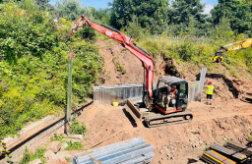
sheet piling on the non-towpath side
As with the other days we are thanked by passers-by along the tow path. It is great to see how many people enjoy the canal. Wednesday night was kayaking night. We were joined by Dave and Alison who were our instructors for the evening. I am not sure what went wrong with my instruction but I spent the time pirouetting my kayak along the canal entertaining all the boat owners and walkers. Even when I hitched a ride with the canoe it stubbornly refused to go forwards allowing me to experience life in the reeds and under the brambles. Everyone else paddled along beautifully all getting back in one piece. Steve had jokingly suggested we try and lose five members so we could afford decent fish and chips! It would have to be plan B for supper.
Lots of activity on Thursday. We ‘newbies’ were all learning bricklaying skills whilst Jordan and Andy provided a neverending supply of cement and concrete. Pilings were inserted from the lock and secured into the bank. We spent the evening with another group of enthusiastic individuals, the Mercia Archers, based in Church Gresley. Following expert instruction we were divided into three teams for a ‘shoot out’. Initially the winning group were to be given a forfeit until Colin realised it may be his team and so changed it to a prize! I think we were all surprised how good we were. I certainly never thought I’d even hit the target.
Friday, and how quickly our final day had come around. I am so glad I took some pictures on the first day as the site has been transformed by the team. Despite the frustrations with equipment and lack of materials being available we have achieved most of the week’s plan. The site has been cleared, clean bricks safely stacked and a significant amount of wall built. Those pesky sheet piles are forming an excellent line from the lock towards the road with supporting rods behind. Great work everyone.
On our way back we called in at Darnford Ecological Park where the group worked last year. It was delightful, saplings sprouting and a diverse array of wild flowers along the banks of the water filled canal. Our little bit will be like that one day. To me the best part was that people were there clearly enjoying the serenity it was providing as they strolled along.
So am I mad? I don’t think so. I have just shared a week in the lives of an amazing group of people, learned a range of skills,

been fed delicious food, worked in beautiful countryside and laughed… a lot. Thanks guys you were all fantastic.
If you are flicking through this issue and wondering if you should join the volunteers, stop dithering and get your name down. You will have a wonderful time.
Julie Howard x
See Progress pages for more on the Lichfield
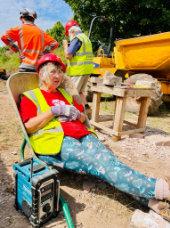
CanalCampscost£80orasstated.BookingforWRGCampswithnumber(egCamp AsheridgeRoad,CheshamHP52PX.Tel:01494783453,enquiries@wrg.org.uk.Diary
Aug24-31 WRG CC2024-17
Sep6-19 WAT
Sep7-8 London WRG
Sep7-8 KESCRG
Sep21-22 wrgBITM
Sep21-22 MBBCS
Sep29Sun WRG
Oct4-17 WAT
CotswoldCanals:WeymoorBridge(week2).Leaders:StephenRice/SandraHorner,cook:
WendoverArm:provisionaldates
CotswoldCanals:jointworkingpartywithKESCRGatWeymoorBridge
CotswoldCanals:jointworkingpartywithLondonWRGatWeymoorBridge
MaidenheadWaterways:BrayCut
Manchester,Bolton&BuryCanal:NobEndLocks
WRGCommittee/BoardMeeting:10:00amatRowingtonVillageHall
WendoverArm:provisionaldates
Oct5-6 London WRG Shrewsbury&NewportCanals
Oct5-6 KESCRG Tobearranged
Oct19-26 WRG CC2024-19
Oct19-20 MBBCS
CoombeswoodCanal.Leaders:NigelLee/Dave‘Evvo’Evans,cook:AnneLilliman
Manchester,Bolton&BuryCanal:NobEndLocks
Oct19-20 wrgBITM CotswoldCanals:WeymoorBridge
Nov1-14 WAT
Nov2-3 WRG
Nov2-3 KESCRG
Nov2-3 London WRG
Nov16-17 MBBCS
Nov16-17 wrgBITM
Nov23-24 wrgNW
Dec7-8 KESCRG
Dec7-8 London WRG
Dec6-19 WAT
WendoverArm:provisionaldates
PossibleReunion(‘BonfireBash’)majorworkingparty:venuewanted!
SupportingWRGReunionifithappens,otherwiseprobablejointdigwithLondonWRG(venue
SupportingWRGReunionifithappens,otherwiseprobablejointdigwithKESCRG(venueto
Manchester,Bolton&BuryCanal:NobEndLocks
MaidenheadWaterways:BrayCut
UttoxeterCanal:ScrubbashingaroundBridge70
Wey&ArunCanal:ChristmasworkingpartywithLondonWRG
Wey&ArunCanal:ChristmasworkingpartywithKESCRG
WendoverArm:provisionaldates
Dec14-15 wrgBITM Tobearranged
Dec21-22
MBBCS
Dec26-Jan1 WRG CC2024-20
Manchester,Bolton&BuryCanal:NobEndLocks
Christmas/NewYearCanalCamp:BuckinghamCanal.Leaders:Dave‘Moose’Hearndenand
CC2024-03)shouldgoto:WRGCanalCamps,Unit16B,FirstFloor,ChilternCourt, DiarycontributionstoDaveWedd,Tel07816175454mdave.wedd@wrgbitm.org.uk
cook:LouKellet
01494-783453 enquiries@wrg.org.uk
Ken Palfrey volunteer@wendovercanal.org.uk
Tim Lewis 07802-518094 london@wrg.org.uk
Ed Walker 07887-568029 ed@edwalker.eclipse.co.uk
Dave Wedd 07816-175454 dave.wedd@wrgbitm.org.uk
Sam Kennion 07843-394161 samklancs@yahoo.com
Mike Palmer mike.palmer@wrg.org.uk
Ken Palfrey volunteer@wendovercanal.org.uk
Tim Lewis 07802-518094 london@wrg.org.uk
Ed Walker 07887-568029 ed@edwalker.eclipse.co.uk 01494-783453 enquiries@wrg.org.uk
Sam Kennion 07843-394161 samklancs@yahoo.com
Dave Wedd 07816-175454 dave.wedd@wrgbitm.org.uk
Ken Palfrey volunteer@wendovercanal.org.uk 01494-783453 enquiries@wrg.org.uk
(venuetobeadvised) Ed Walker 07887-568029 ed@edwalker.eclipse.co.uk tobeadvised) Tim Lewis 07802-518094 london@wrg.org.uk
Sam Kennion 07843-394161 samklancs@yahoo.com
Dave Wedd 07816-175454 dave.wedd@wrgbitm.org.uk
Malcolm Bridge nw@wrg.org.uk
Ed Walker 07887-568029 ed@edwalker.eclipse.co.uk
Tim Lewis 07802-518094 london@wrg.org.uk
Ken Palfrey volunteer@wendovercanal.org.uk
Dave Wedd 07816-175454 dave.wedd@wrgbitm.org.uk
Sam Kennion 07843-394161 samklancs@yahoo.com andNigelLee,cook:MariaHearnden 01494-783453 enquiries@wrg.org.uk
Beginning our roundup of progress in South Devon where the Stover Canal Trust have been waterproofing their canal’s terminus basin
Excavation at the northern terminus of the Stover Canal at Ventiford by Stover Canal Trust was started in 2014, to unearth two hulked barges which had lain beneath the silt for some 100 years. This work was continued the following summer when two more barges were discovered.
During 2016, the basin was cleared of silt by the local clay company, Sibelco, ably assisted by volunteers from Waterway Recovery Group. A small, clay-cored dam was constructed with a view to returning a few hundred metres to water. The Basin was lined with puddling clay and began filling with water in the Autumn of 2019.
All was well over the following winter but come spring it was becoming evident that water was being lost through seepage. After various ‘non-invasive’ methods failed, funding was obtained to enable relining of the basin using a proprietary membrane.
On 25 May this year, with a wet and soggy canal after rain for many weeks, our lead volunteers met with contractor Matt at Ventiford to discuss a programme of works to install Bentotex (a clay liner consisting of natural bentonite clay encapsulated between two geotextiles). to the basin. It was decided that two excavators with drivers, a roller for the fabric and a remote controlled vibrating roller would be required. Matt was also able to supply some Heras fencing. Luckily the rain
stopped a few days before the end of May and it remained dry through until completion on 10 June. Three volunteers erected the fencing on the Sunday evening to isolate the working area from the public. On Monday 3 June at 7.00am we put warning notices out and an information board for the public. With safety inductions done, we took delivery of the first two rolls of Bentotex and started excavating 300mm off the bed of the canal. We cut and placed the Bentotex, sealing the edges and joints with Bentonite granules and Actifil powder, prior to back filling and compacting with the excavated clay. We then did the same again with the next 2.5m width. On the first day, with 7 volunteers and 2 drivers, we had only laid 3 strips of the membrane. However we did get into a routine as the week progressed with
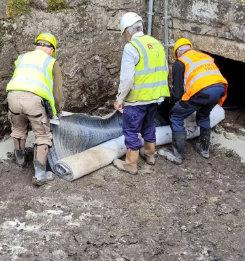
everyone knowing what they had to do. On the Tuesday we had to pump out some standing water before starting but the sun came out and all went well. On the Wednesday we realised that with less clay on the sloping sides we were going to be short of material to backfill over the membrane, so after a couple of frantic phone calls we got 3 loads of clay from Sibelco followed by more as needed on the following days. While excavations were under way several volunteers kept busy clearing weeds off the adjacent granite tramway (a curious ‘railway’ consisting of two parallel rows of shaped granite stones which formed the ‘rails’, and which linked the canal basin to quarries several miles away on Dartmoor). On the Thursday we only had one driver who worked hard driving both machines that day as well as the tractor with the trailer. On the Friday the clay had dried enough to allow the toothed roller to be used along the base and up part of the side slopes but work was not complete until Monday.
We started filling the basin with our daily allocation of water from the local Ventiford Stream. At the time of writing the basin was half full.


Some progress on the behind-the-scenes planning brings more hope of some practical progress on the Missing Mile section before long…
Following lengthy consultations with the Environment Agency (flood modelling), Natural England (biodiversity) and others, earlier this year Stroud District Councillors approved the comprehensive planning application to excavate the Missing Mile – the one mile length of the former Stroudwater Canal which was destroyed as a result of the construction of the M5 motorway in the 1970s, and which is being replaced by a brand new waterway on a different route.
The all-party Committee voted unanimously in favour which continues to reflect the overall support from District Councillors; this is very much welcomed as we move forward with delivering the Cotswold Canals Connected Phase 1B project – the reopening of the canal from Saul Junction on the Gloucester & Sharpness Canal via Whitminster, the Missing Mile and Eastington to the Ocean in Stonehouse, where it meets up with the already restored Phase 1A section to Stroud and beyond.
The planning consent will enable the Phase 1B partnership to reinstate the canal from the A38 roundabout (where the road crossings were constructed several years ago thanks to a grant from Highways England) to Westfield Bridge, including getting under the M5 motorway, building two new locks, canal bunding/towpath construction, and creating a 44boat mooring basin.
Phase 1B Restoration Programme: As you may well be aware if you have been following the progress of the Cotswold Canals Phase 1B project, we are now well behind budgeted timescale (1B was originally due for completion in October 2025) due mainly to around 18 months of Covid lockdown delays and the planning delay for the Missing Mile following the lengthy pre-application consultations.
The Phase 1B Project is also considerably over budget. Delays have meant we are now in a period of high inflation, compared to our 2020 cost base, which is significantly increasing the costs. The original cash cost for Phase 1B was £20 million; this is currently forecast to increase by at least £10 million.
The engineering team is therefore re-evaluating all designs and costs to try and minimise this funding gap. Rob Benson has recently been employed as our new CCC Phase 1B Chief Engineer. Rob has been in post for around five months and is already making some good progress, especially on the two major cost increase items totaling some £5 million (50%) of the cost increase: the M5 underpass (a cunning solution involving creating a canal channel alongside the River Frome to pass under the M5 using the existing river bridge) and Walk Bridge (replacing a low-level road crossing which forms the first obstacle from the Saul Junction end of the canal.
Although Cotswold Canals Trust (and other) volunteers will not be involved in delivering these two major works, we are assessing how to maximise volunteer-led activities to minimise Phase 1B project costs. We are therefore setting up two CCT project teams, one for Phase 1B and one for Phase 1A to assess the total workload, timings, costs, resources and gaps in plant, equipment, volunteers and funding.
The Phase 1B team's priority is to have the Ocean - Westfield Bridge canal length (Section 3 of Phase 1B) completed by 2025, being a National Lottery Heritage Fund deadline. Key volunteer-led works, to include visiting Waterway Recovery Group volunteers, include the five locks, Oldbury Brook Aqueduct, stabilising Bond's Mill Embankment and dredging. A replacement Bond's Mill Lift Bridge is going out to tender soon for contractor delivery. Section 3 of Phase 1B is fully funded.
We hope to be able to start volunteer work in 2024 on Section 2 of Phase 1B (The Missing Mile). Although planning permission has been granted, landowner agreements and planning conditions still need to be finalised and additional funding secured. The volunteer work will include excavating some 85,000 cubic metres of ground for the new canal channel & boat basin, flood banks and two new locks. The intention is to work from the A38 roundabout going eastwards.
Phase 1A: Of course, we cannot ignore Phase 1A, the length from Stonehouse via Stroud to just short of Brimscombe Port. Although officially restored in 2018, since then there has been a never-ending need to try and keep this section dredged due to the various Stroud Valleys streams discharging silt into the canal - in particular this winter which has been one of the wettest on record.
The new Phase 1A team is therefore assessing the works needed to ensure this section is navigable when Phase 1B is re-connected to Saul Junction. The Phase 1A project team comprises both CCT & Stroud Valleys Canal Company (SVCC) directors and will be considering the various maintenance requirements including secure water supply, moorings, locks, bridges, towpaths and the ongoing dredging.
Target date for completion is the end of 2027, based on the assumption that Phase 1B should be navigable sometime in 2028 (to be confirmed!).
Canal Volunteering: The Missing Mile go-ahead significantly increases the volunteer-led workload and we are therefore hoping that Cotswold Canals Trust volunteer-led teams will be working a minimum of four days per week. This does NOT mean that volunteers are expected to do four days! We will almost certainly need more volunteers to achieve this, using combinations of volunteers each willing to commit to 1, 2, 3 or 4 days each. This is in addition to visiting volunteer groups from WRG and the other mobile teams.
Obviously, the Phase 18 project is not going to plan for various reasons, mostly out of our control (Covid-19, Russia's war in Ukraine, severe inflation). The good news is that the National Lottery Heritage Fund (which is supplying the largest single contribution to the funding) recognises and understands this, giving us more time and indications that some (not all!) additional funding could be available. We have been asked to submit firm costs to include volunteerled activities and sustainability by the end of 2024 when a further review will take place.
Saul Junction
Walk Bridge To Gloucester Whitminster Lock New Lock needed

A38 roundabout: new bridges built
‘Missing Mile’ new section of canal needed
Westfield (John Robinson) Lock under restoration Canal to run alongside River Frome under existing M5 motorway bridge
Dock Lock Pike Lock Blunder Lock
New Oldbury Aqueduct / culvert to be built
New lock needed Replacement Bond’s Mill Swing Bridge needed
Ocean Railway Bridge (already rebuilt)
Adapted from a report in CCT magazine The Trow by John Newton, CCT Vice-Chair & Project Director
Phase 1A section through Stroud restored
Shropshire Union Canal Society’s volunteers continue rebuilding the channel south from Crickheath - and unearth a ghost boat!
Shropshire Union Canal Society
Crickheath South work party reportJune 21-23 and July 5-7, 2024: This report covers two work parties on our Crickheath South project (rebuilding the next section of the Montgomery Canal channel southwards from Crickheath Wharf, the limit of navigation since last year’s reopening) as some additions have been made to the schedule over the summer. Both were highly productive. The main activities were work on the banks where the channel has been newly lined and blocked (the liner covered with a protective layer of concrete blocks) and continuing work to place copings back on the newly repaired wharf wall.
With lining and blocking almost complete in Phase 1B (the end of the site towards the new Schoolhouse Bridge), attention turned to the area at the top of the banks above the blocks. The solution differs between the towpath side and the offside banks. On the towpath side, the method to protect the liners from (just below) water
level to the towpath is the same as previously used: the liners are covered with medium-sized aggregate (‘riprap’) which in turn is covered with soil. By Saturday of the July work party, this had been completed.
An alternative solution was used on the off side bank. This, at times tricky and fiddly task, was completed over the two work parties. An outstanding effort was made by Society volunteers to complete laying the second course of blocks during the June work party. Each one of these specialist blocks has to be very carefully manually positioned and interlocked without the use of mortar.
That then left the area behind this ‘retaining wall’ to be infilled. Particularly challenging was a stretch at the southern end of the site where there was no haul road and therefore no plant access from the top of the bank. Due to the slope of the bank and vulnerability of the uncovered liner system, this had to be done manually.
Right on cue, an army (well, 17) of corporate volunteers from Openreach turned up on Friday of the July work party eager to get stuck in. So large was the group that
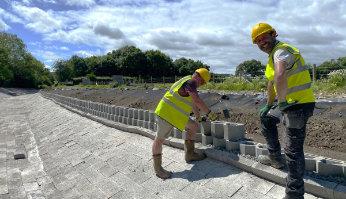
Laying the final few concrete blocks on the completed section of channel

No prizes for guessing where the corporate volunteers were from!
they split into three teams. Countless barrow-loads later and by mid afternoon, the job was done. A special thanks to all of them – we look forward to seeing you next time! Thanks too to all the Society’s volunteers who have made such rapid progress over these two work parties aided by six new volunteers in the last month alone.
Whilst the hive of activity to complete the banks was under way in Phase 1B, the wallers, members of the Dry Stone Walling Association and assisted by Canal Society volunteers, have been steadily progressing the completion of the wharf wall repairs in Phase 1A (the part of the site nearest to
Crickheath). The result looks impressive and if the weather is kind this should be completed next month.
SUCS Crickheath South work party report - July 26-28, 2024: This report covers the second work party in July including the days leading up to it. As previously reported, due to the extremely wet winter and remaining high ground water levels, works in Phase 1A at the north end of the site by Crickheath Wharf have been delayed. To ensure all necessary work is completed before this section fills with water again over winter (or in the autumn!), a

Laying soil to cover the channel liner from the water level upwards
contractor George was engaged from the start of the week to profile the channel. Society volunteers continued the job during the work party and enormous progress has now been made. Work to upgrade the towpath in this area has also started. Last year, thanks to a generous grant from the Oswestry Rural Parish Council, the towpath was improved from a muddy slip and trip hazard to a hard surface. Now, as heavy plant operations draw to a conclusion in much of this area, the finished spec towpath can be constructed without fear of damage by the heavier works. This work party, a total of 32 metres of towpath was constructed.
There is still much more to do but we are now ahead of schedule.
It’s official! Confirmation of what SUCS volunteers have always known –the Society has aglobalfollowing. Tony, a follower from Sydney, was so impressed he recently travelled to the UK to volunteer at the June work party (possibly not the sole reason for travelling).

Phase 1B also saw tremendous progress with towpath construction completed, construction of a temporary dam at the north end of the section and, with a heroic effort on Saturday, lining and blocking finished by ‘close of play’. Thanks to all the volunteers who pulled out all the stops to achieve this on a rather wet and muddy site. There just remains a small length of bank above water level to finish off next work party.
Finally, it must be recorded the remains of a ‘ghost boat’ were unearthed. Local resident Roy advises the boat was reputedly haunted after the owner was killed by a guillotine lock. No one else wished to operate the boat and it was eventually abandoned at the south end of Crickheath Wharf.
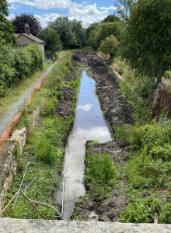
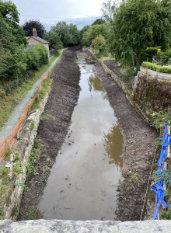
The go-ahead has been given for work which will link up sections of restored and newly built canal on the outskirts of Lichfield city
Canal
Important news for the Lichfield & Hatherton Canals Restoration Trust’s future work in the Lichfield area is that planning approval has been granted for the restoration of another section of the canal, between Cricket Lane and London Road in Lichfield.
This links together the existing work sites at Borrowcop Locks (Tamworth Road), Gallows Wharf (near London Road Bridge) and St John’s Grange.
The planning approval includes the construction of a 650 metre water-tight canal channel from London Road to the existing old Lock 24 in Borrowcop Locks Canal Park, building a new replacement Lock 24 to the west of Cricket Lane, a new lift bridge linking Longbridge Road with Tamworth Road, and new pedestrian steps from Gallows Wharf to London Road. Derek Lord, Planning and Technical Trustee, with LHCRT, says “This is a huge milestone for us and we can now start the longawaited work on the canal along Tamworth Road, creating a full length of channel from Borrowcop Locks Canal Park to St John’s Grange.
“The first stage will be to build the canal channel from London Road and install the pedestrian liftbridge to give access from Longbridge Road to Tamworth Road, for which we raised substantial funds through our Big Give appeal. Our volunteers will then continue to build the canal channel towards Cricket Lane and make it water-ready. “Our aim is to get as much of the canal in water as soon as possible, so we will incorporate stop planks or dams along the route to enable this to happen. We will also carry out additional landscaping work with planting, including more trees, to increase biodiversity.”
At Borrowcop Locks, the chambers of Locks 25 and 26 have already been restored, as has the length of canal between them; the former Lock 24 has been rebuilt as a water feature, and the length below Lock 26 has been restored and extended around a sharp bend, as the first part of a diversion which will eventually pass under the A51 and A38 main roads on its way to Darnford Lane and the Coventry Canal.
Lock 24 is being replaced by a new lock on the far side of Cricket Lane, with the intervening length of canal lowered to facilitate getting the restored canal under Cricket Lane (where it would not be permitted to reinstate the original hump-backed bridge).
At the other end of the length of canal that has been given planning consent, it links up with sections of restored and newly built canal (part of a diversion around a obstructed length) which already has a partly-prepared channel at St John’s Grange, with two navigable canal culverts under access roads to new housing developments; these were constructed by Amey for Persimmon Homes. Amey will also install the all-importantnavigable canal culvert beneath Cricket Lane, as part of the new Persimmon Homes housing development at that location.
All in all the completion of the new section will result in a continuous restored length through the outskirts of Lichfield, running from the A51 crossing via Tamworth Road Locks 25 and 26, a new bridge under Cricket Lane, a new Lock 24, a new lift bridge, the existing restored section at Gallows Wharf and surviving London Road Bridge, and the channel at St John’s Grange, to reach as far as the railway crossing by the Birmingham Road.
For more about the Lichfield Canal restoration, see page 15 for the Camp Report from the first of two weeks’ Canal Camps on the Lichfield Canal.
The planning and preliminaries are done, the ground-breaking ceremony is over, the real work starts on the Staveley project
As reported in the last issue, 17 May saw the official ground-breaking ceremony on the section of the Chesterfield Canal heading eastwards from the Staveley end of the six-mile isolated navigable Chesterfield-Staveley length. This is currently being restored with funding from the Staveley Town Deal, and includes two new bridges (a farm crossing and a bridge for the Trans-Pennine Trail, a long distance footpath and cycleway based on one of the two disused railways which cross the site) plus a new lock, channel works, and a lot of clay-shifting to reinstate the major embankment crossing the Doe Lea Valley.
The event was well attended by politicians and the press, and the contractor, O’Brien, even presented the Canal Trust with a commemorative spade! But with the formalities out of the way, the real works have begun.
Most of the focus has been on creating temporary footpaths along the old railway and around the site of the new bridge. These have enabled the existing paths through the site to be closed during the works, which is much safer for the general public and the contractor. The first section of permanent footpath works has also been completed, and this is now in use.
We have started removing the old ramp that carried the Trans-Pennine Trail across the line of the canal, and have created access to the foundation points for the bridge ready to begin piling.
The initial work is now complete, so work on site was paused until later in the summer. The next job will be starting to pile for the bridge foundations. Meanwhile, the bridge fabrication is underway at the CTS factory in Huddersfield - I’m visiting them soon to see progress, so look out in the next issue for more photographs. George Rogers, Project Director
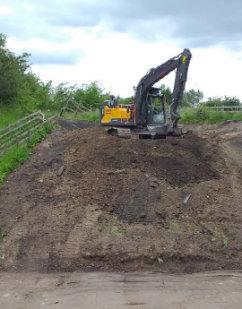
Removing the old Trans-Pennine Trail ramp which blocked the canal

Length: 46 miles Locks: originally 65 Closed: in stages from 1907
Staveley to Chesterfield restored: 6 miles 6 locks (including new Staveley Town Lock)
Worksop to Kiveton restored and reopened in 2002: 6 miles 31 locks (including 1 extra added)
Staveley Town Deal project
Kiveton to Staveley unnavigable ‘missing link’ including current restoration sites: 8 miles 14 locks (originally)
West Stockwith to Worksop saved from closure in 1960s: 26 miles 16 locks
SNCT are continuing to make good progress on their Wappenshall Junction warehouses project, as well as restoring their first lift bridge
Work on the Shrewsbury and Newport canals continues now we seem to have a summer! Wappenshall Wharf, the location of the historic warehouses at the meeting point of the two canals, which the Shrewsbury & Newport Canals Trust is turning into community centre and canal centre, is coming on really well now, with the external work to lay block paving around the smaller warehouse that will become our café.
We now have our fibre optic cable Wi-Fi connection installed and all security cameras up and working. The stable block, which was demolished during the Second World War, is now being re-built. It will have seven stable doors and will house all our tools and equipment, presently temporarily stored in a shipping container. Once it’s complete and all kit has been moved into it, we can sell the shipping container, which will enable work to start on re-surfacing the car park area with permeable paving blocks. New block paving laid outside the smaller warehouse at Wappenshall
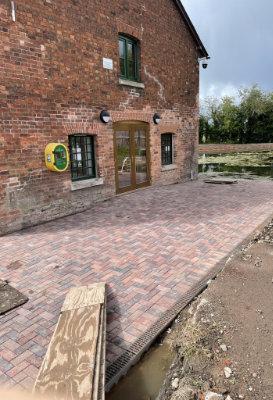
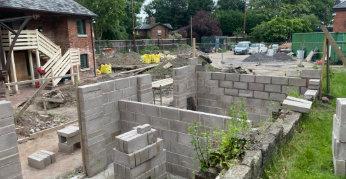
The Local Authority has finally approved our overall drainage plan, which will allow us to complete the sewage plant outfall.
Meanwhile on the actual canal, work continues at the Berwick Tunnel south portal. The new composting loo has been installed, which will ensure our volunteers can work without having to cross their legs! Our dumper truck engine has been rebuilt and the dumper will soon be in action alongside our JCB to start dredging this section of the canal. Elsewhere the lift bridge at Rodington is well under construction now. Below is a shot of the brickwork that is being rebuilt. Although most of the metal parts have been found, another exploratory dig is underway close to Wappenshall at the site of another similar lift bridge, to unearth any of the parts we don’t yet have.
BernieJones


As a change from progress on maintaining their historic craft, the Wooden Canal Boat Society report a cruise on two of their boats…
It isn’t just about restoring canals. Regular readers will be familiar with the reports that appear periodically in Navvies reporting on the Wooden Canal Boat Society’s efforts to preserve various examples of different types of historic working and ex-working narrow boats – in particular those with timber-built hulls. Of all the craft which plied their trade on the waterways from the earliest days to the final decline of regular freight in the 1960s, the majority were wooden. However they have become increasingly rare in recent decades as numbers dwindled and later iron- and steel-built boats began to heavily outnumber them.
But WCBS don’t just restore and maintain them; they try to make sure the boats get out and about on the waterways around their base at Ashton-under-Lyne, east of Manchester. By way of a change from the usual restoration reports, here’s an account of an interesting recent trip by WCBS with motor boat Forget-me-Not towing unpowered butty boat Hazel from Ashton through Manchester to Lymm and back.
Incidentally there is a link with canal
restoration: both the Ashton Canal and the length of the Rochdale through central Manchester were restored from dereliction and reopened in the 1970s - see our Archive article in the last issue of Navvies…
Taking the boats to waterway events is great fun, but a lot of hard work for some of us. Usually we go to the Middlewich Folk & Boat Festival and the Lymm Historic Transport Day. This year we had to miss out the Middlewich event. I was under a lot of pressure to get Hazel ready because we didn’t have as many volunteers as last year. Another difficult factor was the monsoon-like conditions that have prevailed for most of this year. Anyway, we made it to Lymm, just! Helen Sherry made several trips from Leicester to do the much needed repainting of the cabin sides. We also had a fairly comprehensive internal repaint and some modifications to the heating so the pump now switches itself on automatically and the radiators actually get hot!
Amazingly we managed to get the

Lymm trip done in the first window of sunshine this year (possibly the last!)
We set out from Ashton about midday on 19 June, with Hazel’s batteries newly charged. It’s about an hour’s run to Fairfield, where we worked down the two locks, before tying up above Lock 16 for a late lunch.
ToRuncorn
From 16 down to 8 the locks are close together, so the motor boat goes on ahead in its own and the butty follows, bowhauled on a rope from the bank, Aaron Booth providing the ‘horse power’. Maxine Bailey steered the motor and I was running up and down setting locks, working the motor through and then drawing a paddle to refill the lock for the butty.
By the time we reached Lock 11 I was getting concerned that there was no sign of the butty following. It turned out that she was stuck in a low pound (my bad, I hadn’t noticed that one of the bottom paddles wasn’t properly down) and Aaron, trying to budge the grounded boat, had been catapulted into the cut by the spring in the line.
Luckily the sun soon dried Aaron and there was plenty of water in the pounds
above to refloat the boat.
DukinfieldJunction
When I first navigated this canal in 1977 there was a swing bridge carrying a road over lock 13, beside the Strawberry Duck pub. You had to wait for a gap in the road traffic before swinging the bridge and working the lock in the face of impatient motorists. The bridge is long gone but the route is still a busy footpath - and a favourite spot for dumping stuff in the canal. This time the motor sat on rubbish with the lock empty and we had to flush her out. The butty, drawing only 2 feet, had the same problem.
Below Lock 8 we moored the motor and I walked up to meet the butty, which soon appeared out of Lock 9 at Clayton Lane. We towed along the relatively long pound between 8 and 7, then separated again for the closely packed locks past the Etihad
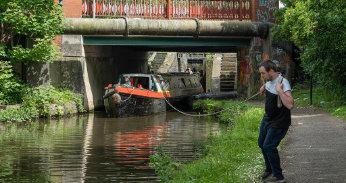
Bow-hauling
Stadium and the new Co-op Live venue, where there was a long queue over the canal bridge. Some of the concert goers were interested in the boats and we had a few brief conversations with them.
I suddenly realised that the sole of my left boot was flapping. My only other footwear was a pair of slippers. I quickly changed my left foot into a slipper and worked the last few locks lopsided…
Below Lock 4 there is a wide basin, rarely occupied by boats. This is where we planned to spend the night. Unusually a steel boat, or, at least, the shell of one, was tied on the far side. This was presumably intended as visitor moorings for Sportcity. Mooring rings are provided, but it is little used, largely because of the area’s reputation for vandalism against boats. The bankside is now getting tatty and overgrown.
We breasted up below the lock and, with the aid of the shaft, moved the pair over to tie next to the steel boat. I headed for the tram, wearing slippers, and gave Emuna a surprise visit to change into alternative footwear before getting the tram back to the boat. Thank goodness for my bus pass!
The couple from the other boat stopped for a chat as they left for home. They were fitting out the boat to live on. It had no engine and they were under the misapprehension that, if you didn’t have an engine, you didn’t need a licence. Sadly, that’s not the case! They asked for a tow to Manchester next day. I said that we would
leave at 10 and they could hang on behind the butty as far as the first lock.
All day we had been followed by a photographer, John Tickner. He was keen to get photos of historic boats in urban and industrial settings. He took his leave and arranged to meet us again the next day.
Over Christmas, Nessie had fixed up a folding bike with a 6 speed deraillieur to be used on Hazel trips. In the morning I made the first use of it, riding up to the massive Asda supermarket near lock 7 to buy some provisions. After breakfast, Maxine walked to the nearby Etihad tram stop to head home. This left just me, Helen and Aaron to shepherd the two boats through Manchester.
Our friends from the steel boat didn’t show up by the time we left at about 10.15, Aaron going on ahead to set Lock 3 and Helen steering the butty. I worked the motor through and went on to the next lock, leaving Aaron and Helen to follow with the butty. The towpath is closed here for construction works, so Aaron had to propel the butty with a shaft. I worked through Lock 2, then refilled it for the butty, following the same procedure for Lock 1, then we set off through the 1990s Piccadilly Village development, with its decorative arms and basins that have never been used for boats.
The Ashton and Rochdale canals were rivals and the connection between them near Manchester’s Piccadilly Station is secretive and sinuous. It’s quite a difficult route with a pair of boats. Apart from a slight cock-up when shortening the towline, we managed it

If there isn’t a towpath, the butty crew resort to poling the boat with the shaft
without touching the sides. On entering the Rochdale at right angles it’s necessary to breast up in not much more than a boats length, then swing through 90 degrees to approach the first of the nine wide locks leading down through the city centre.
As we were impeccably negotiating this manoevre a young couple of South Asian descent engaged me in conversation from the walkway alongside an office building. I suggested they meet us at the lock. As usual, water was pouring over the gates at Dale St Lock. I was surprised to find that the couple had followed my suggestion, and appeared on the lockside. I explained a little about the boats and the society. The man asked how much it would cost to join us for a trip. I suggested they climb aboard and give us a donation. They sat down in Hazel’s fore end and I gave them a safety talk as the boats descended the lock. The man handed over a £20 note.
It would simplify working these locks if we could go through them with the boats breasted side by side. Unfortunately some of the gates don’t open fully and if you try to pass through breasted the boats will jam, and take ages to get free. So I towed on a short strap and showed Helen the technique of quickly getting a line tied between Hazel’s timberhead and the motor’s dolly to stop the butty before she crashed into the bottom gates. It worked most times!
Our impromptu guests left us at the rainbow decorated Canal St Lock, where we struggled to get the boats out of the bottom
gates. A couple of locks further on we had to pull the butty out first because the gate on the motor’s side would not open enough for her to get out and she had to shuffle over to the other side. Then pick the butty up below the lock.
The glass towers of Manchester rose above us as we descended the flight. Some boats caught us up as we struggled with the difficult gates. In turn, at the final lock, we caught up with a boater who was having a drunken argument with his partner as, can in hand, he worked their boat through.
At last, were on the wide and relatively deep Bridgewater canal. Our photographer friend left us. I handed over the motor to Aaron and enjoyed a quiet life steering the butty out through the Manchester suburbs and into the countryside to tie for the night at Dunham Massey.
Next morning it was a relatively short run on to Lymm. We breasted up and tied before the main moorings to find out where we were to go. We’d hardly got our mooring pins in when Bob Lear, the harbourmaster, arrived to give us our orders. I wasn’t particularly pleased at our location, rather out of the way of most visitors. We moved on, but found a pleasure boat occupying our space, so we carried on to the winding hole, winded and returned. The interloper was just leaving, encouraged by Bob, when we got back.
Liz had booked us a space on the main field for a stall and Emuna (Queen of the Tombolas) had put together a fine spread of
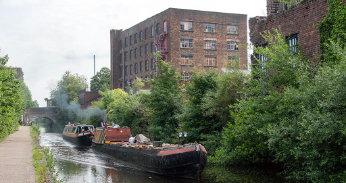
Heading through Ancoats into central Manchester
items, all numbered and listed, to be gambled over by the good people of Cheshire. It all needed transporting.
Sadly, the station for Lymm was closed in about 1962. There is, however, a reasonable bus service, so I walked into the centre just in time to see a bus leaving. This gave me time to get something to eat and drink from the adjacent supermarket before catching the next one.
The bus took me to Altrincham station, from where I joined evening commuters for the rest of the journey back to Ashton. Bus pass again!
The next day was Saturday. I collected the gazebo, the boxed up tombola and everything else that might be useful and drove to Lymm.
On Sunday morning smoke rose from the car park on the opposite side of the canal as the traction engines raised steam. I drove the loaded van up to the main field, where all the historic motor vehicles would park up and set up our stall to hand over to Liz. My role for the day was to be on board Hazel, chatting with passers by and trying to tempt them to become sponsors. I also spent a bit of time looking at traction engines and boats, as well as chatting with the new owner of Parbella, the ‘Duker Packet’ Bridgewater Canal barge that I used to run carrying grain between Liverpool and Frodsham.
The tombola did really well, raising £171 for our funds. The boat parade, usually the highlight of the day for me, was a bit
farcical this time. Usually, boats start up at about 4pm and pass the centre of Lymm in an orderly manner. This time, the instructions were that the first boat would pass through the bridge at 4pm. It seemed like everybody was in a hurry to get away. Engines started up at about 3.30pm and boats jostled for place like they were starting a Grand Prix.
Shortly before setting out we met a lady called Stacey with three kids on the towpath. She was very interested in our project so we invited her along. A surprise towpath meeting was boatbuilder Ian Riley, who I hadn’t seen for decades, and Anna Barrick, his partner. They came along too.
We started the engine bang on 4pm. but, by the time we reached the centre the other boats had gone. The commentator announced that Forget me Not was a Barlows boat from Braunston, even though I’d sent the correct information. We caught up with the rest of the boats in a huge boat jam alongside the Lymm Cruising Club moorings.
There’s normally some congestion here as one by one boats turn at the winding hole just outside Lymm, but this time it was crazy. The boats that started together had all reached the winding hole together. We breasted up and gradually moved forward, occassionally meeting a boat that had just winded. Pleasure cruisers, eager to get back to their home moorings, or the pub, pushed past us. So did a rubber dinghy powered by a huge outboard.

On the Rochdale Canal descending through central Manchester
A lot of boats that were heading towards Manchester didn’t bother winding but just set off. Eventually we were able to wind and singled out to head back into Lymm, meeting the huge bulk of Parbella in the relatively narrow stretch leading up to Lymm Bridge. In the centre most people seemed to have gone home.
We winded again at the other end of Lymm. Forget me Not’s engine demonstrated what was to become an annoying habit on the return trip: cutting out when changing gear. We tied, breasted, in the centre of Lymm.
It was now about 6pm and our stall was still up in the main field. I collected the van from the out of the way street where it was parked and drove up there. Liz and Helen helped dismantle the stall and we soon had it all in the van. I drove back to Ashton and spent a night at home before again joining the commuters on a train to Altrincham. This time, instead of getting the bus, I detrained at Navigation Road and used the folding bike to cycle to Lymm along the abandoned railway track.
The return trip was pleasant and uneventful. The good weather held and we tied at Lock 89 of the Rochdale Canal, in central Manchester. This is where the short restored section of the Manchester & Salford Junction canal leaves the Rochdale. It leads to a basin outside the Bridgewater Hall, but its entrance is permanently padlocked.
Nearby is a delightfully unspoiled Victorian pub called the Peveril of the Peak.
This is an amazing survival, surrounded by towering office blocks. The brewery wanted to modernise it recently, but a campaign saved it. Apparently they’re now trying to ruin the nearby British Protection instead. After tea, some of us went out and enjoyed a late pint in the old pub. We struck up conversation with a young man with bobbed hair who, it seems, had more boating experience than any of us. He offered to join us in the morning and I was looking forward to learning from his immense expertise, and so disappointed when he didn’t show up.
As we worked up the Rochdale locks, then the Ashton, lockwheeling volunteers started appearing on the towpath. Aaron did his tireless ‘boat horse’ impersonation, bowhauling the butty between the narrow locks. Portland Basin was reached just after 7pm and Hazel was taken over the aqueduct to Dukinfield for her batteries to be charged at the premises of Dixon & Smith (Motor Engineers) .
A wonderful trip was ended.
Would you like to take part in interesting trips like this one? Would you like to learn how to handle a traditional pair of wooden boats? The Wooden Canal Boat Society needs more crew volunteers, particularly those with some boating experience who would like to learn to skipper a motor and butty. Email chriswcbs@gmail.com or ring 07931 952 037.
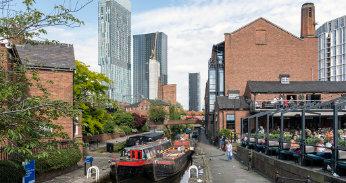
Duke’s Lock, the final lock before the Rochdale meets the Bridgewater Canal at Castlefield
WRG recently received the donation of the entire collection of Navvies magazine which had belonged to the late David Smith, husband of former IWA National Chair Audrey Smith. Rather than simply offer them free to a good home (and possibly end up struggling to find one, as the magazines are all online and accessible via the IWA website, and the few of us who want paper copies have mostly already got a set), Mike Palmer took them along to the WRG Training Weekend and Leader Training Day. They were handed out to the volunteers present, who were asked to scan through one of the issues from years gone by, and pick up on a few memorable items which they found “particularly interesting / shocking / amazing / entertaining.” Here are just a few…

From Navvies 100: “The ‘Nothing Changes’section made me laugh…”
it?)
Quote from "Navvies Notebook” No. 6, December 1967: "Found at Marple: 1 brown bobble hat, 2 tin plates, 1 red mug, 1 dessert spoon. Would the owner please contact Liz Dodwell and recover". This followed the London and Home Counties Branch IWA Working Party Group's first ever visit to the derelict Peak Forest Canal in September 1967.
London WRG (more or less direct descendant of the original London W.P.G.) had a sort-out of their van prior to lending it to the Basingstoke work comp. The junk more than filled Bob's dustbin but included: 3 shirts, 13 gloves, 1 brown shoe (size 9), 1 pair nylon waterproof trousers, 1 pair blue underpants, 17 "Casey Jones" burger wrappers or cups plus numerous empty crisp bags etc. If the owners wish to recover their belongings, they should contact Croydon Refuse Collection Department

Fast-forward to 2024 and the Editor can confirm nothing has changed yet as regards stuff left in the London WRG van
From Navvies 157: “I was only reminiscing recently with fellow WRGies about the Bring a Boat Weekends. Something to do again?”
We certainly do seem to have had a fair bit in that particular issue about boating - the Bring a Boat dig, Canalway Cavalcade at Little Venice, the stalwarts of the Wooden Canal Boat Society who are still at it today as reported in this issue, and the remarkable pedal powered boat Escargot (right) that WRG BITM
pedalled from Dudley to Henley. In fact I’m feeling happier now about the 6-page WCBS boat trip report in this issue …Ed.
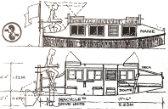

From Navvies 189: in the editorial column, the news that “apparently Roger Scruton, of all people, may have owned a bit of the Wilts & Berks Canal - and objected to its restoration”.Also a Camp Report which “reminded me how much fun my first ever camp was” and the fact that people used to write to the letters page - “Those were the days!”
The Roger Scruton thing (about which all I could remember was that my computer called him “Roger Scrotum” - enough said) was part of a lengthy editorial bemoaning the way the non-waterways press appeared to have gone a bit anti canal restoration recently. The Telegraph had been rounding up opponents of the Cotswold scheme for a horribly biased piece, the Yorkshire Post dismissed the Huddersfield restoration as being on a par with the Dome for wasting money, and Scruton in the FT reckoned his part of Wiltshire was “heritage free” and the recent WRG camp on it was unwanted. Perhaps he’d rather they built a reservoir (see page 4) instead. …Ed
From Navvies 191: in the editorial column (in contrast to issue 189) the news that “It’s all going terribly well”. Also a reminiscence about accommodation in an earlier era which made our contributor “laugh out loud” (it involved overimbibing, indecent exposure, and the police walking around the hall tripping over sleeping bodies); and a “genius” letter from Jon Sims in response to suggestions that we ought to consider splashing out on colour printing…

Dear Martin, May I suggest a cheap and effective two-colour process to solve your printing problems?
With the next edition of 'Navvies', you send every subscriber a cheap pack of felt tip pens. They then follow these instructions:
1. Use the red pen to colour in any vehicles or tee shirts.
2. Use the brown pen to colour in everything else.
3. Donate the rest of the pens to their local primary school.
Navvies in colour and great PR into the bargain. Brilliant!
Following earlier concerns reported in these pages regarding how to fill in accident, incident and near-miss paperwork properly, we have received this definitive “How not to do it”…
Whilst utilising a manually-operated personal janitorial ground clearance device for its original and intended function, an explosive disintegration into a trio of subsections of the cylindrical operating lever was experienced by the volunteer operator.
A minimum of one of the aforementioned subsections travelled at a considerable velocity within close proximity of one auditory appendage of the volunteer operative, narrowly avoiding an abrupt deceleration against their cranium. Due the aforesaid high velocity of the disintegration, it was not identified as to whether the dexter or sinister appendage was the item threatened.
The subsections involved were deposited in a flexible polyvinyl-chloride waste material disposal receptacle. Prevention of future incidents was attempted thorough the purchase of a replacement item manufactured to a substantially higher quality standard than the failed item from a reputable merchant of ironmongery with which The Association maintains account facilities. The aforementioned replacement implement was refinished into the correct shade of crimson hue with which the relevant integral organisation of The Association is particularly identified.
It has subsequently been observed by both the originally implicated volunteer and a witness in close proximity to them that the established adage “a tidy site is a safe site” might upon this particular occasion have been inaccurate to a not inconsiderable extent.
(In case you haven’t worked it out they seem to have almost whacked themself on the ear with a broken broom handle when it snapped while they were sweeping up on site!)
